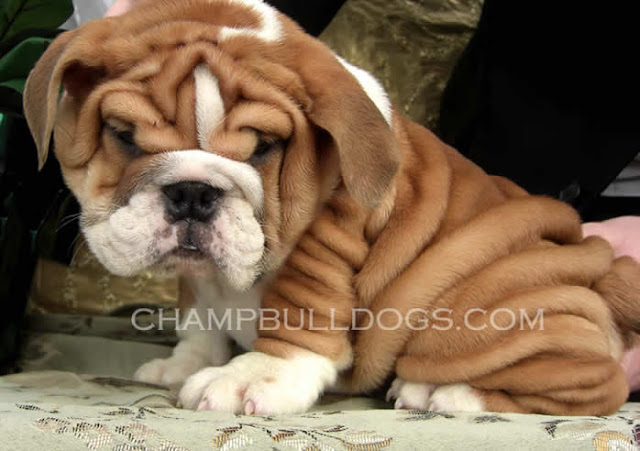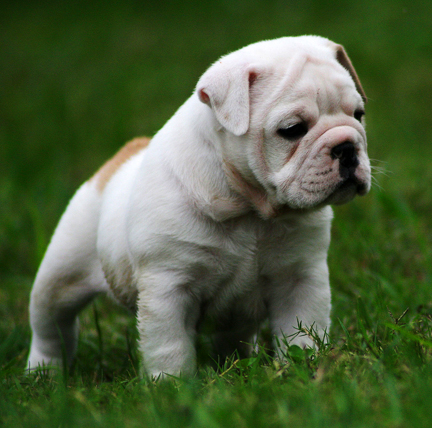The Bulldog is also known as: English Bulldog
Fast FactsGroup classification: Non-Sporting Country of origin: England Date of origin: 13th century
Weight (M): 50 lb Height (M): 13 - 15" Life expectancy: 8 - 11 years
Weight (F): 40 lb Height (F): 12 - 14"
Fast FactsGroup classification: Non-Sporting Country of origin: England Date of origin: 13th century
Weight (M): 50 lb Height (M): 13 - 15" Life expectancy: 8 - 11 years
Weight (F): 40 lb Height (F): 12 - 14"
General Description of the Bulldog
The Bulldog is a medium sized dog whose build suggests strength and vitality. It is a stocky dog with broad shoulders and a large, short head. The eyes are moderately sized, round and dark, and set wide apart and low away from the ears. The ears are small and thin, placed wide and far back on the skull. The head is broad and square, held high with a short profile and flat forehead. The nose is large and black, with the tip set deeply angled towards the eyes. The muzzle is extremely short and turned upward with large teeth and a level bite. The tail can be either straight or corkscrewed and is always held low. The coat is straight, short, and flat with a smooth feel and glossy look. The skin around the face and neck should be loose and covered with wrinkles. The color of the coat may be brindle, red, fawn, fallow or solid white.
The Bulldog is a medium sized dog whose build suggests strength and vitality. It is a stocky dog with broad shoulders and a large, short head. The eyes are moderately sized, round and dark, and set wide apart and low away from the ears. The ears are small and thin, placed wide and far back on the skull. The head is broad and square, held high with a short profile and flat forehead. The nose is large and black, with the tip set deeply angled towards the eyes. The muzzle is extremely short and turned upward with large teeth and a level bite. The tail can be either straight or corkscrewed and is always held low. The coat is straight, short, and flat with a smooth feel and glossy look. The skin around the face and neck should be loose and covered with wrinkles. The color of the coat may be brindle, red, fawn, fallow or solid white.
Bulldog Temperament
Don’t let the Bulldog’s scowling visage fool you, because those sagging jowls can just as easily be turned into a smile only a mother could love. For a dog that was bred to go toe to toe with bulls, the Bulldog is extraordinarily docile and gentle. Anyone who has spent any time with this breed will tell you that they are truly affectionate, and much more likely to lick your face than bite your head off. Bulldogs are kind with children and cats, and sociable around strangers. Strange dogs are another story, however, and perhaps the only time you will see a Bulldog act aggressive and mean is in the presence of a dog it just doesn’t like; this behavior is especially prevalent among males. The Bulldog is quite playful, but it will oftentimes need to be goaded into physical activity, as it is innately dormant and somewhat lazy.
Don’t let the Bulldog’s scowling visage fool you, because those sagging jowls can just as easily be turned into a smile only a mother could love. For a dog that was bred to go toe to toe with bulls, the Bulldog is extraordinarily docile and gentle. Anyone who has spent any time with this breed will tell you that they are truly affectionate, and much more likely to lick your face than bite your head off. Bulldogs are kind with children and cats, and sociable around strangers. Strange dogs are another story, however, and perhaps the only time you will see a Bulldog act aggressive and mean is in the presence of a dog it just doesn’t like; this behavior is especially prevalent among males. The Bulldog is quite playful, but it will oftentimes need to be goaded into physical activity, as it is innately dormant and somewhat lazy.
Caring for a Bulldog
The Bulldog is an ideal dog for apartment life as it is fairly inactive indoors. They have trouble cooling off in hot weather and chill easily so a temperate climate is ideal. The Bulldog is notoriously lethargic and neither desires nor requires a lot of exercise. A short, brisk walk around the neighborhood every day is sufficient. This breed is an average shedder; it needs a brushing several times a week and the wrinkles on its face cleaned with a damp cloth often. Bathe your Bulldog only when you find it necessary. Bulldogs may have trouble breathing in humid weather and often snore at night. They do not like water, and generally cannot swim. Hereditary health issues are rather common in this breed, and include canine hip dysplasia, shoulder luxation, elongated soft palate, internalized tail, stenotic nares, ventricular septal defect and KCS. Other, less common, concerns include patellar luxation, entropion, ectropion, distichiasis and demodicosis.
The Bulldog is an ideal dog for apartment life as it is fairly inactive indoors. They have trouble cooling off in hot weather and chill easily so a temperate climate is ideal. The Bulldog is notoriously lethargic and neither desires nor requires a lot of exercise. A short, brisk walk around the neighborhood every day is sufficient. This breed is an average shedder; it needs a brushing several times a week and the wrinkles on its face cleaned with a damp cloth often. Bathe your Bulldog only when you find it necessary. Bulldogs may have trouble breathing in humid weather and often snore at night. They do not like water, and generally cannot swim. Hereditary health issues are rather common in this breed, and include canine hip dysplasia, shoulder luxation, elongated soft palate, internalized tail, stenotic nares, ventricular septal defect and KCS. Other, less common, concerns include patellar luxation, entropion, ectropion, distichiasis and demodicosis.


























































